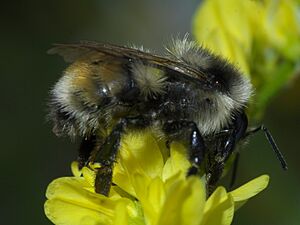Two-form bumblebee facts for kids
Quick facts for kids Two-form bumblebee |
|
|---|---|
 |
|
| Conservation status | |
| Scientific classification | |
| Genus: |
Bombus
|
| Species: |
bifarius
|
Bombus bifarius, also known as the two-form bumblebee, is a type of bumblebee. These bees live together in groups, like a family, which is called being eusocial.
You can find Bombus bifarius in the mountains of western North America. They mostly live in places like Colorado and Utah. Its name, "two-form," is a bit old-fashioned now. People used to think this bumblebee came in two different colors: one with a red tail and one with a black tail. But scientists recently found out that the black-tailed bees are actually a different species called Bombus vancouverensis. So, the true Bombus bifarius only has a red tail, meaning it's not "two-formed" at all!
Contents
What is the Two-Form Bumblebee?
Bombus bifarius was first described by a scientist named Ezra Townsend Cresson in 1878. It belongs to a large group of insects called Hymenoptera. This group also includes other bees like honey bees and orchid bees.
For a long time, people believed that Bombus bifarius had different color patterns. The two main patterns were called "nominate" (red-tailed) and "nearcticus" (black-tailed). Red-tailed bees were found from Colorado all the way up to British Columbia. However, scientists discovered that these red-tailed bees were actually two different species: bifarius and Bombus vancouverensis. The black-tailed pattern, found mostly in western Canada and the US, belongs only to vancouverensis.
Since 2013, scientists have been discussing whether these different color patterns meant there were more than one species. By 2020, it was confirmed that bifarius and vancouverensis are indeed separate species. They have different genetic makeups, even though they look very similar.
How to Identify Bombus bifarius
Bombus bifarius bumblebees are fairly small. Worker bees are about 8 to 14 millimeters long. Queen bees are a bit bigger, ranging from 15 to 19 millimeters. Their bodies are covered with short, even hair.
The hair on their faces is usually yellow or white. Sometimes, they have black hair on the top of their heads. The lower part of their thorax (the middle section of their body) is black. Their back legs and the pollen baskets on their legs are brownish-orange. The hairs on the second and third sections of their abdomen (the metasomal tergites) are red.
Male vs. Female Bumblebees
Male Bombus bifarius bees are similar in size to the female worker bees, usually 8 to 13 millimeters long. Their eyes are also similar in size and shape to the females. The colors on their bodies are much like those of the workers and queens.
Where Does Bombus bifarius Live?
Bombus bifarius lives in the mountains of western North America. You can find them in specific areas. These include northern Arizona, Colorado, northern New Mexico, Utah, and southern Wyoming.
Any populations of bees that were once thought to be bifarius in other areas actually belong to the species B. vancouverensis. So, the true Bombus bifarius has a more limited home range than previously believed.


